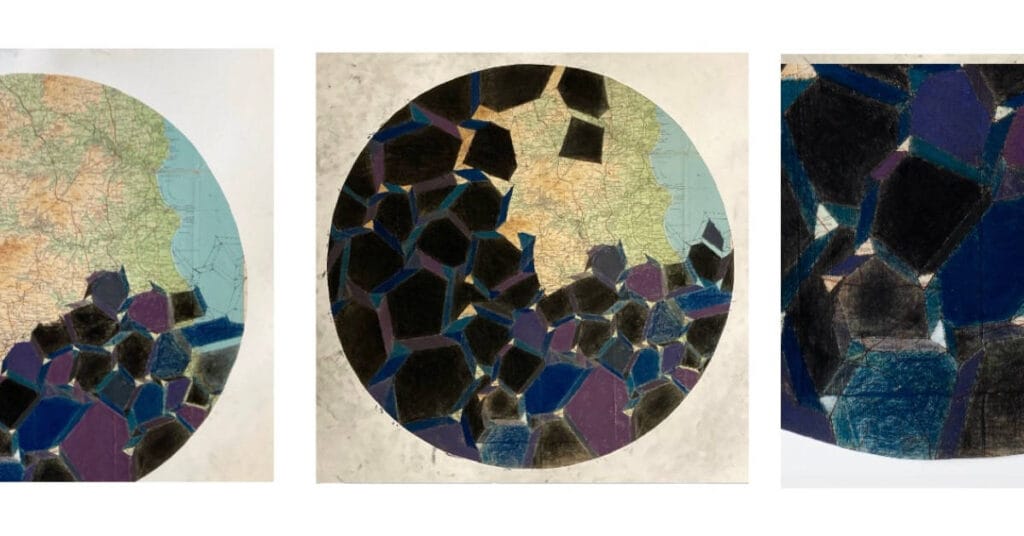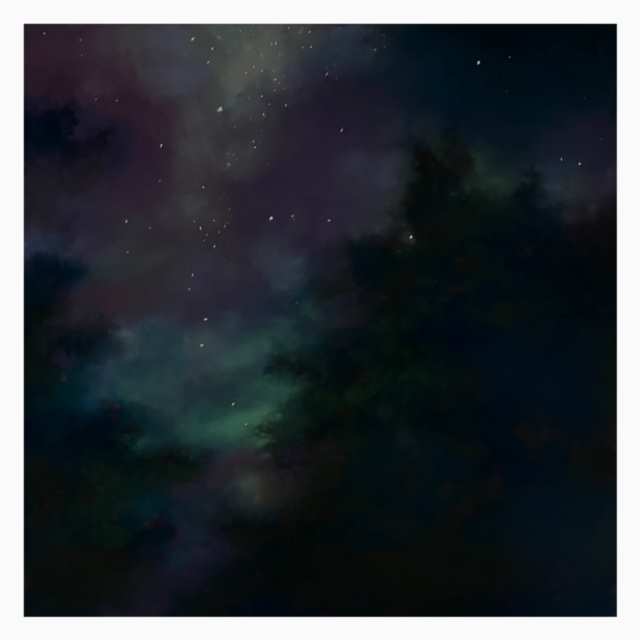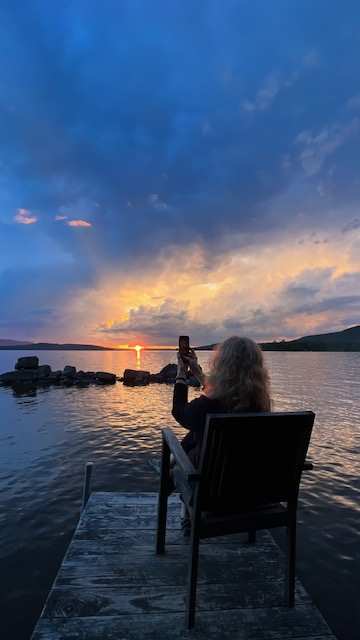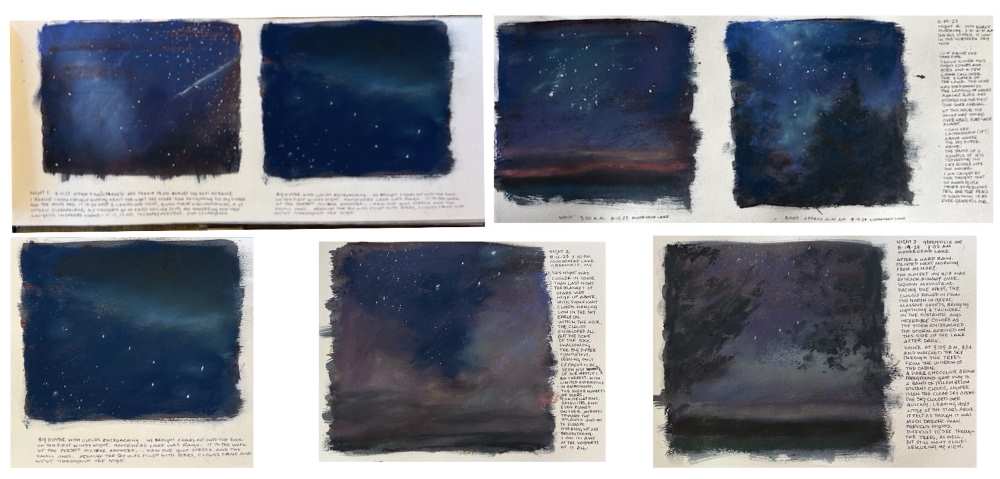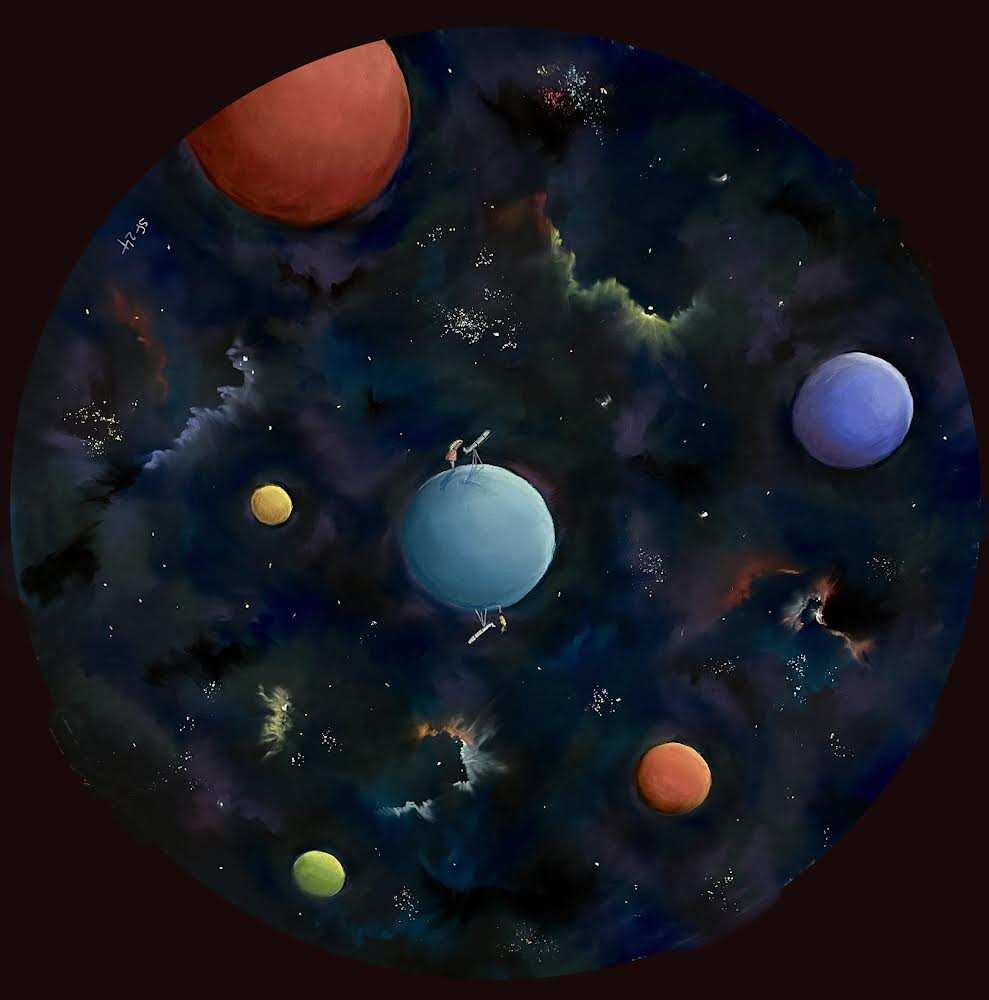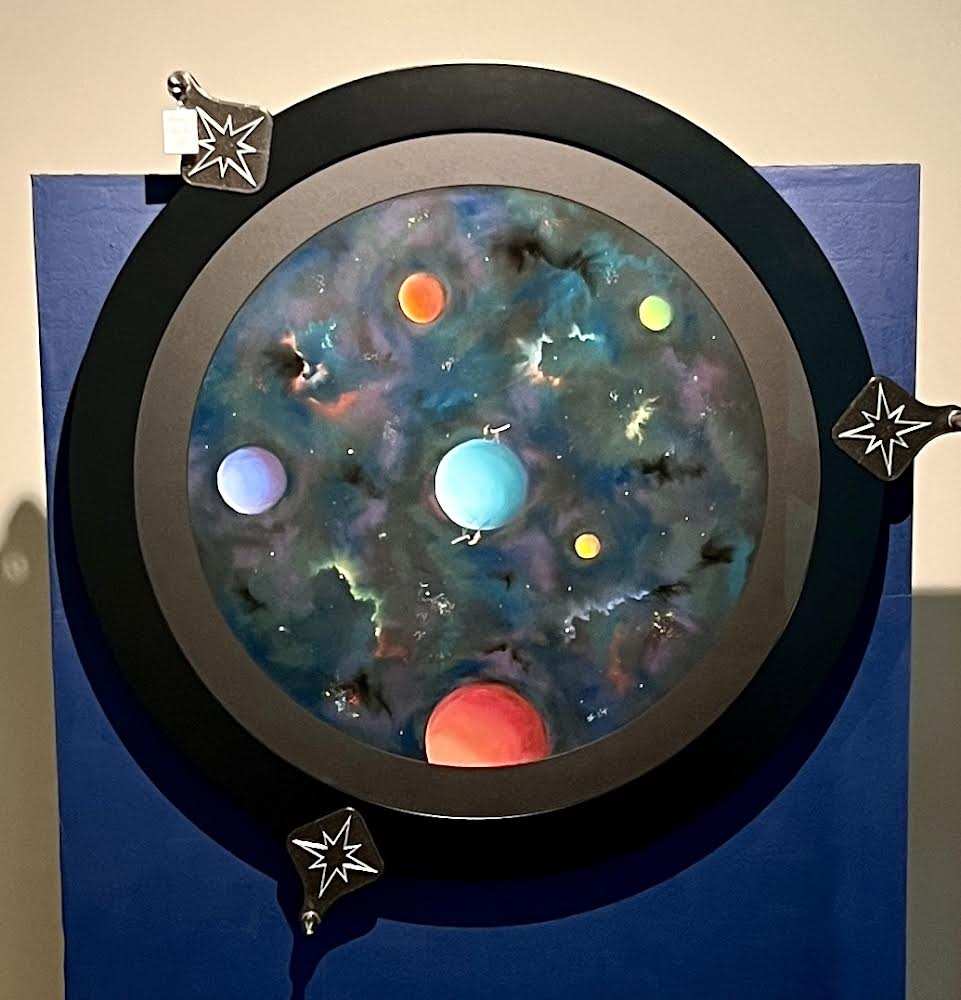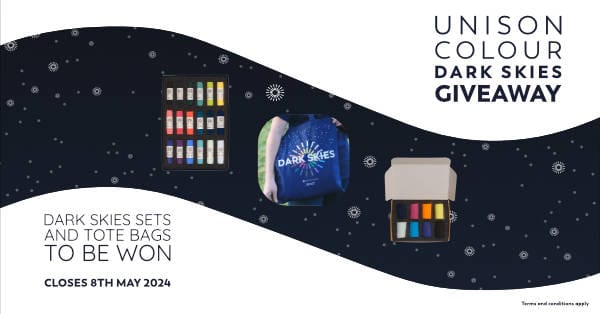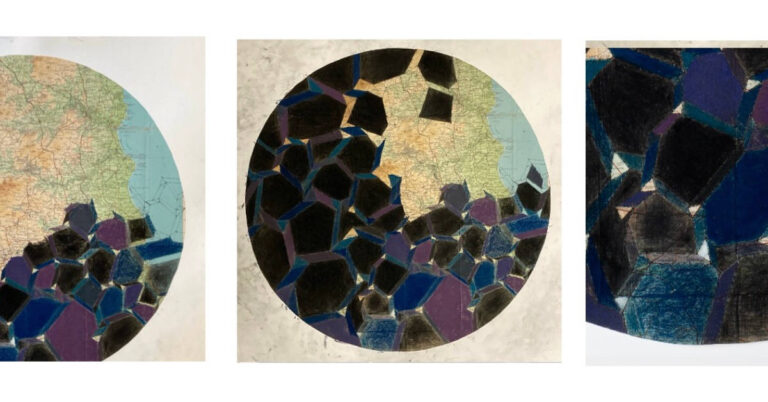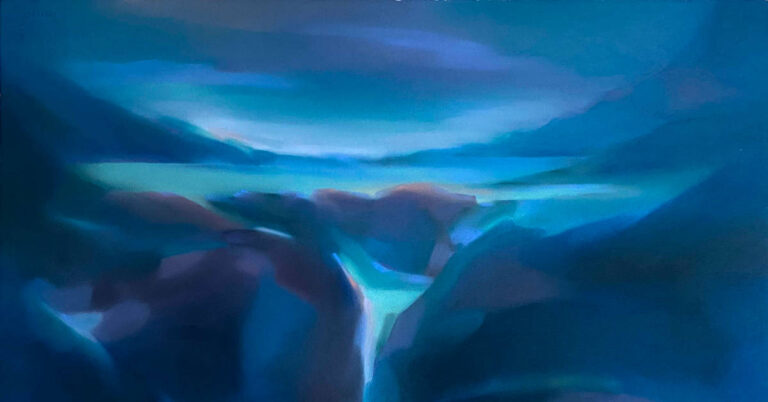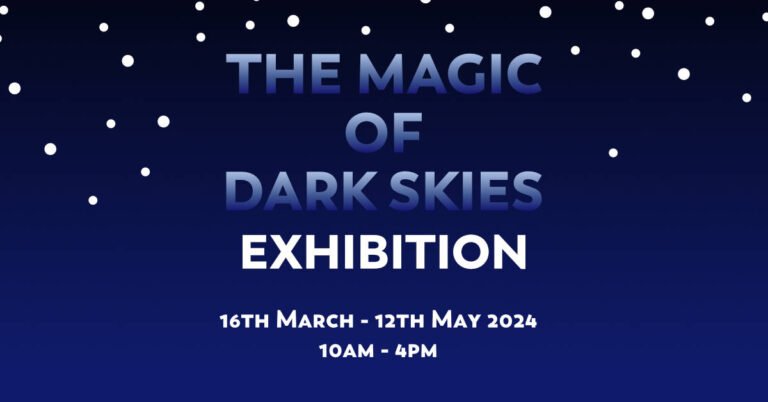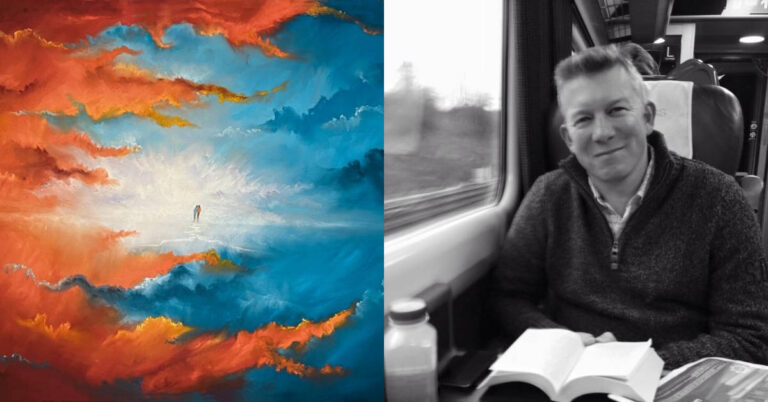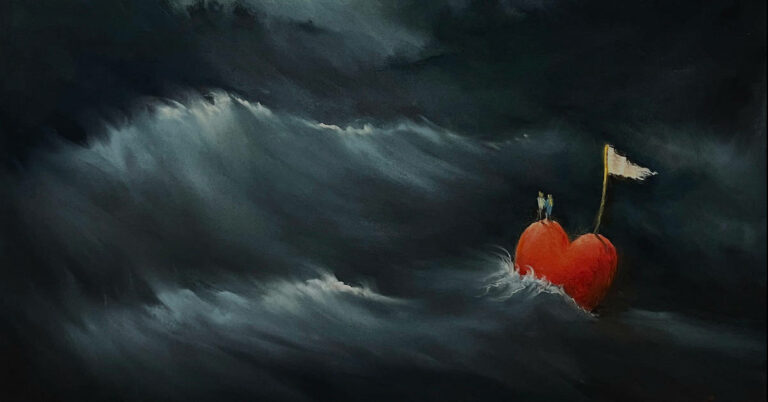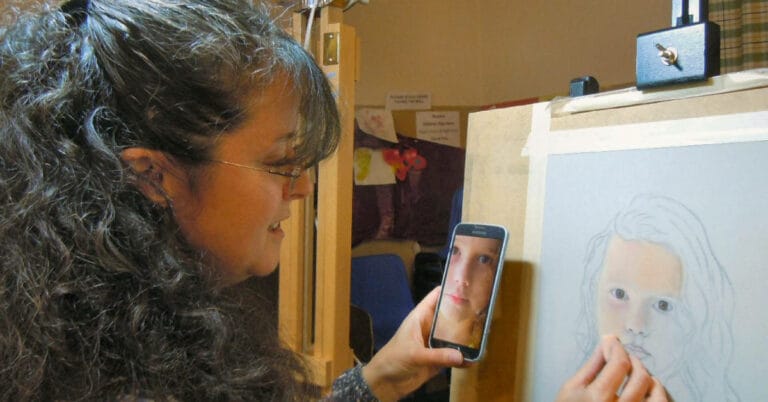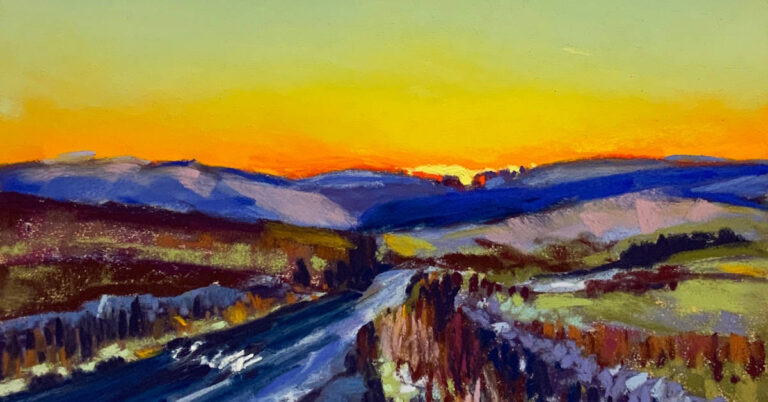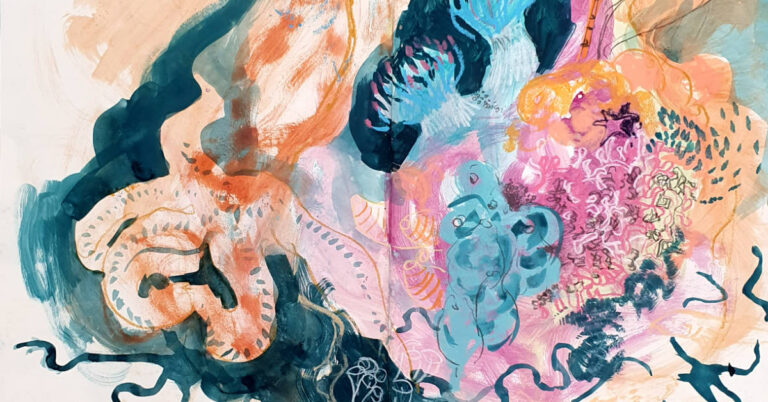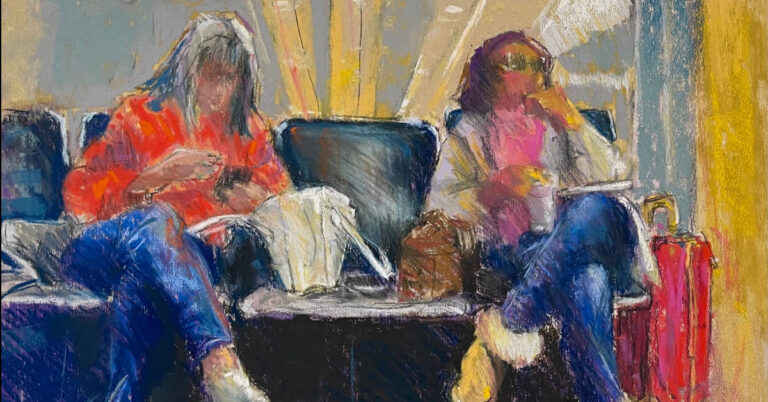Unison Colour recently invited 6 national and international artists to produce new artworks under the theme of Dark Skies, which are being displayed at The Sill in Northumberland from 16th March – 12th May 2024, coinciding with the annual International Dark Skies Awareness week in the first week of April.
Two of the selected artists are Unison Colour Associate Artists living under designated Dark Skies in the UK: Stephen Fuller and Amy Shuckburgh, with an additional two Associate Artists who live under Dark Skies elsewhere around the world: Lyn Asselta and Kristin Holm Dybvig. The two other participating artists are based in Northumberland: William Morrison Bell and Matilda Bevan.
Before we see the paintings these artists created and speak to them about their work, let’s explore the meaning and importance of having, and maintaining, areas of dark sky.
What is the significance of a Dark Sky Park?
In 2013 Northumberland National Park became an official designated Dark Sky Park and, covering 572 square miles, is in fact the largest gold-tier dark sky park in Europe. Essentially this means it is the least light-polluted spot in England, with 96% of the park enjoying extremely low levels of light pollution allowing the darkest and starriest skies in the country.
On completely moonless nights, the Milky Way and even the Andromeda Galaxy, a staggering 2.5 million lightyears away, can be seen stretching out across the clear night skies. Typically autumn and winter nights are darkest and best for viewing deep sky objects such as galaxies and nebulae, while in summer you can view star clusters, shooting stars and the moon and the sun’s surface. It’s because of this that the region attracts professional and amateur astronomers and stargazers from across the country.
What is Light Pollution and why does it matter?
Light pollution refers to the excessive or misdirected artificial light produced by human activities, which disrupts the natural darkness of the night sky and affects various organisms and ecosystems.
It matters to nature because it interferes with the natural rhythms and behaviours of many species, including birds, insects, and mammals, disrupting migration patterns, breeding cycles, and feeding habits. This light pollution affects ecosystems, by altering predator-prey dynamics and impacting plant growth and reproduction.
Moreover, excessive artificial light at night can also have adverse effects on our own health, as studies have shown artificial light at night can disrupt human circadian rhythms, leading to sleep disturbances and other related health issues.
It also wastes energy and contributes to skyglow, making it difficult to observe stars and celestial objects.
According to the World Atlas of Artificial Night Sky Brightness “80% of the world’s population lives under sky glow. In the US and Europe, 99%of the public cannot experience a natural night sky where they live”. So with much of the Earth’s population living under light polluted skies, over-lighting is an International concern.
Therefore, addressing light pollution is crucial for protecting the environment by preserving the integrity of natural habitats and promoting the well-being of both wildlife and humans.
The good news is that light pollution, unlike many other forms of pollution, is reversible to some extent.
How is Unison Colour helping to educate and promote Dark Skies?
There is an obvious synergy between the designated Dark Skies of Northumberland and Unison Colours much loved handmade soft pastels, as they are crafted with such care by hand in the same region. This represents such a harmonious fusion of natural beauty and tactile artistic materials.
So the Unison Colour Dark Skies set of soft pastels were created, and used by all the artists involved in this exhibition to create their own vision and interpretation of what Dark Skies meant to them. It is a set which helps to capture both the ethereal colours and textures of the night sky together with deep, velvety hues which echo the richness of the cosmos above.
So now let’s look at the artists involved, the artworks produced and delve deeper into their creation and the inspirations behind them:
In Part One we will speak to Lynn Asselta and Stephen Fuller. Part Two features Kristin Holm Dybvig and Amy Shuckburgh, with Part Three concluding the series with William Morrison-Bell and Matilda Bevan.
LYN ASSELTA
Associate Artist of Unison Colour
Lyn Asselta is a very accomplished Associate Artist for Unison Colour, who lives in Maine in the USA. She is a highly awarded pastelist as well as teacher , author and is well known for atmospheric and dramatic landscapes.
1. What inspired you to create this artwork, Waiting For Nightfall, for Unison Colour Soft Pastels representing Dark Skies?
After spending several nights observing the sky, under cloudy conditions, one of the things that struck me was the “completeness” of the night… the overarching sense of darkness, enough that it seemed to almost press down toward us as we sat out there. I wanted to recreate the feeling of those cloudy dark skies, with small patches of stars coming through, but to make the feeling of the painting such that it would seem almost as if the darkness could envelope you.
2. How did you approach capturing the essence of Dark Skies in your artwork?
I would spend quite a bit of time observing during the night, sitting at the end of a small dock on the edge of this large lake, then I would wake early the next morning and make small, pastel sketches of what I remembered. I wanted to work from the feel of what I experienced as much as what I saw and I didn’t want to rely on photos as reference for a larger piece. Although I did take photos, I wanted a sense of something remembered to permeate this piece and I found that working largely from memory with just a sketch as a reference kept me closer to that feeling.
3. Can you tell me about the techniques or additional mediums you used to convey the feeling of Dark Skies, and show stages of the creative process that you went through to complete your piece?
Since the panel I was working on was made from Pastel Premier sanded paper in white, mounted to an archival museum board, I felt it was important to tone the paper first so I could get the richest, deepest colour possible. I used a liquid pigment in Prussian blue to wash over the entire panel prior to beginning the application of pastel. I worked from one of the small sketches I had done originally, trying to create something that represented what I had witnessed on the nights that I spent outside observing. One of the things that truly surprised me was how perfect the range and choice of colours in the Unison Dark Skies set was. I was initially taken aback by the brighter colours in the set, but once I started layering and blending them with the darkest colours, the depth they created together was absolutely brilliant, in my opinion.
4. Did you encounter any specific challenges to this piece, and if so, how did you overcome them ?
Only the weather! We had a few days to visit the dark sky area near Greenville, Maine, hoping to see the Perseid meteor shower while we were there, but the weather was overcast, cloudy, and windy most of the time. I was worried I wouldn’t have enough reference material for working on this larger piece in the studio later on. But photos, combined with notes taken and small paintings from memory in my sketchbook each morning, served to really jog my memory and to help with the painting process.
5. What emotions or atmospheres were you aiming to evoke in viewers with this piece?
See answer number 1
6. Did you draw from personal experiences or specific locations when creating this representation of Dark Skies?
This painting came from several nights of observation in Greenville, Maine, USA, a designated Dark Sky park that is several hours north of where I live, and is located on the edge of Moosehead Lake. Although many parts of Maine are dark due to being less populated, I wanted the experience of actually being in/near a designated dark sky area.
7. How do you think your artwork contributes to the broader conversation about preserving and appreciating natural darkness?
I would hope that my painting evokes a sense of memory, one that is both personal, gained from experience, and one that might be more deep-seated, an anthropological sort of memory. To me, I’d love for this painting to serve as a reminder of a common, shared human experience, but a reminder that might also encourage someone to get outside in the night and lay under the stars, taking in the enormity of it all and sensing the peace to be found in the heavens. I believe that experiencing these skies is the way to realize the importance of them, and of experiences in the natural world that go beyond the everyday. Listening to nature under these dark skies fosters a deeper connection, also, a realization that nature needs these areas devoid of human interference as much or more than we do.
Where can we see more of your art?
My work can be found on my website: www.lynasselta.com
Facebook: Lyn Asselta pastel painter
Instagram: lynasseltafineart
STEPHEN FULLER
Associate Artist of Unison Colour
Stephen Fuller is based in Cornwall and also spends a lot of time painting in Scotland. His art is influenced by the heady mix of science and wild seascapes sprinkled with romance and whimsy, and represents the beauty of light and drama in the sea and sky with evocative, moody and enigmatic paintings.
1. What inspired you to create this artwork for Unison Colour Soft Pastels representing Dark Skies?
I was thrilled to be contacted by Victoria, the Creative Projects Manager at Unison Colour, earlier last year; when she asked me to take part in the Dark Skies exhibition. I am a Chartered Physicist and former member of the Institute of Physics with a particular interest in Astrophysics, so it seemed a wonderful opportunity. Additionally, during part of my 30 year service career as an aircraft engineer in the Royal Navy, I ran the RN innovation centre, which turned me into something akin to a crazy garden shed Victorian scientist. This inspired me to try and make my piece more than just a picture and possibly something never seen before. So, in summary, this piece gave me the opportunity to combine astrophysics, engineering, innovation and art – in short a little piece of heaven.
2. How did you approach capturing the essence of Dark Skies in your artwork?
It is fair to say that the Hubble Telescope (and more recently the James Webb telescope) have transformed how we perceive the Universe. A whole new generation of children (and adults), via these telescopes and the internet, have had almost instant access to the most amazing photographs of celestial wonders. I wanted to capture that look and feeling in my piece as here on Earth the closest you can get to these images are locations with pristine dark skies.
3. Can you tell me about the techniques or additional mediums you used to convey the feeling of Dark Skies, and show stages of the creative process that you went through to complete your piece?
I initially envisaged a rectangular piece that could be hung in any of the four different ways and my early test pieces could do this. I then considered that this theme would be even more interesting if the piece was circular and had a number of strings that allowed you to hang the piece in a number of orientations. The next obvious iteration of this idea was a circular piece that had a rotating mount and could be oriented in any way you wanted. In Western culture we tend to view a picture from left to right and from top to bottom; we also tend to paint with this subconscious cultural bias. In order to make the picture work as it was rotated I felt it was important to be able to paint the picture in a number of orientations as well. As such I ended up building a rotating easel as well as a rotating mount. One great bonus from this rotating easel was that it turned out to be very good for setting up a camera and filming and has been used several times since.
Once I had settled on the circular idea this led me to explore a number of other ideas – I considered making the piece look like a planisphere (star chart) and have 3D printed silhouette horizon scenery around the edge. Another idea was to 3D print attachments to go around the outside of the circular frame to make it look like an old-fashioned ship’s wheel with the associated strong attachment to navigation using the stars. In the end I felt that these 2 options could look more like a craft project and not a showcase for the amazing Unison Colour pastels so rejected them. The next idea was to include a number of vignettes around the outside of the piece all with a strong attachment to the stars: an old fashioned sailing ship, Lanyon Quoit (Cornwall’s mini Stonehenge), Goonhilly Radio telescopes, a church and a tin mine (all the elements are made in the stars). Although I developed a number of pieces with these vignettes I rejected them for the final piece as I felt that the detracted from the simplicity of the magic of dark skies.
Apart from the depiction of dark absorption nebulae (described below) I used very little pure black in the piece. The Unison Dark Skies set had a nice range of darks and I mixed and blended these throughout the piece to hopefully achieve a much more interesting dark sky.
Adding a random starscape with stars of different colours and sizes was something of a challenge (it’s very hard for humans to create randomness as we tend towards pattern like movement). In the end I solved this problem by moving the piece to be horizontal on the floor and holding a pastel some distance above it. I then scraped a razor over the pastel and let the dust fall which achieved a lovely random effect. You had to be careful to avoid even the smallest of draughts as these tended to generate lines of stars. This technique is also very good for generating random spray in breaking waves.
4. Did you encounter any specific challenges to this piece, and if so, how did you overcome them?
The first real challenge was finding a suitable pastel surface in a large enough size. I wanted the piece to be large and a real statement. I knew I was going to do lots of blending of dark and lighter tones to create the sky that I wanted so I didn’t want anything with too much texture. This meant that I couldn’t really use a pastel ground on top of wood or board.
Luckily I found Pastelmat (one of my favourite papers) in a large enough size to meet the maximum dimensions given by Victoria. I had to buy 5 sheets but I’ll have plenty for future projects.
My next challenge was to find a circular mount and frame of sufficient size and quality. I also wanted to use AR70 art glass as I knew that reflections would kill any mood / effect in a dark piece of this size. There was absolutely nothing available off the shelf so I ended up with a firm based in Soho, London who could use a CNC machine to make a frame of any size and shape. Although it was expensive and a well-known national courier managed to lose it for a week or so – when it arrived it was obviously a real triumph and actually makes the piece.
Finding a way to make the piece rotate did require some thought. I initially explored the route of sourcing suitable bearings and material to make a bespoke rotating mount using a local engineering firm. However, a lucky find when searching the internet located a plasma TV wall mount that was designed for the largest TVs and also rotated through 360 degrees.
When the mount arrived it locked every 90 degrees so I had to use some ingenuity and an engineering “fix” to sort this issue. I ended up utilising 2 of these mounts – one for the picture and one for the large rotating easel I built to actually allow me to produce the piece.
Suitable handles weren’t really available to attach to the mount to allow a viewer to turn the picture. I have a small 3D printer farm at home and as a result was able to design and print my own. Another lucky internet find was starry night sparkle filament which was perfect to make the handles out of. I actually designed the handles so they didn’t touch the front of the mount so that I could remove them without any damage to the mount should I wish to change the frame use in the future.
Once I had a rotating mount and first tested it on the wall there was a slight moment of concern. The connecting structure which joined the frame to the rotating mount wasn’t rigid enough and the was an alarming amount of flex as it was rotated. Whilst there was no chance it would fall off the wall it didn’t really inspire confidence. Some more design work and the addition of some more angle iron support really fixed the issue.
Eventually, I ended up with a large circular, rigid rotating piece that actually achieved the effect I was hoping for.
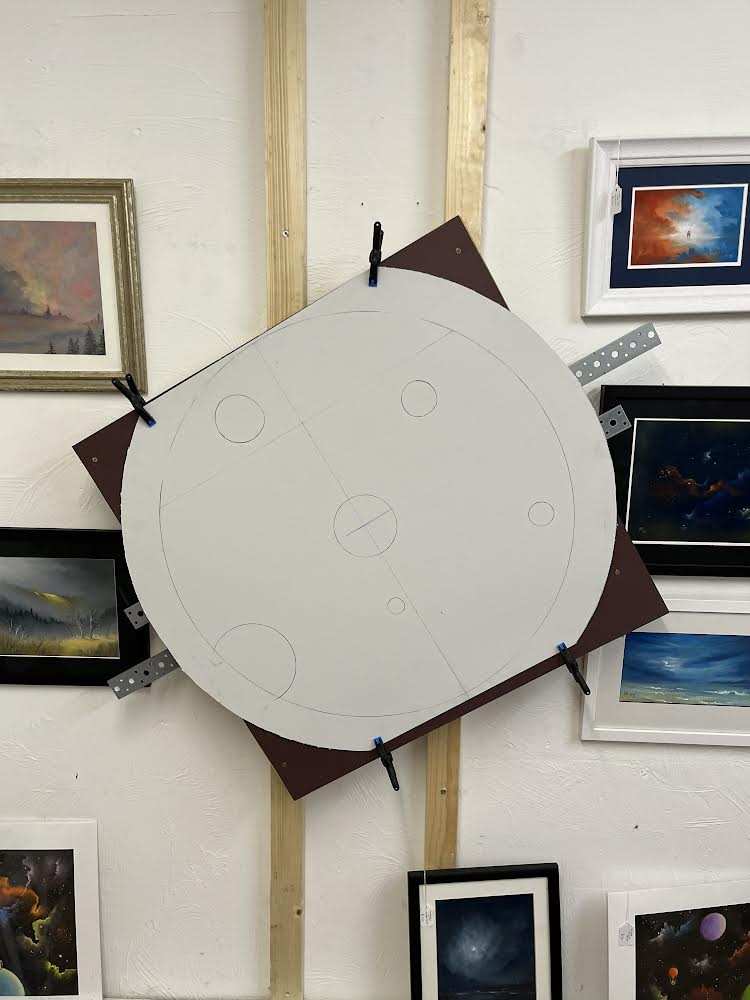
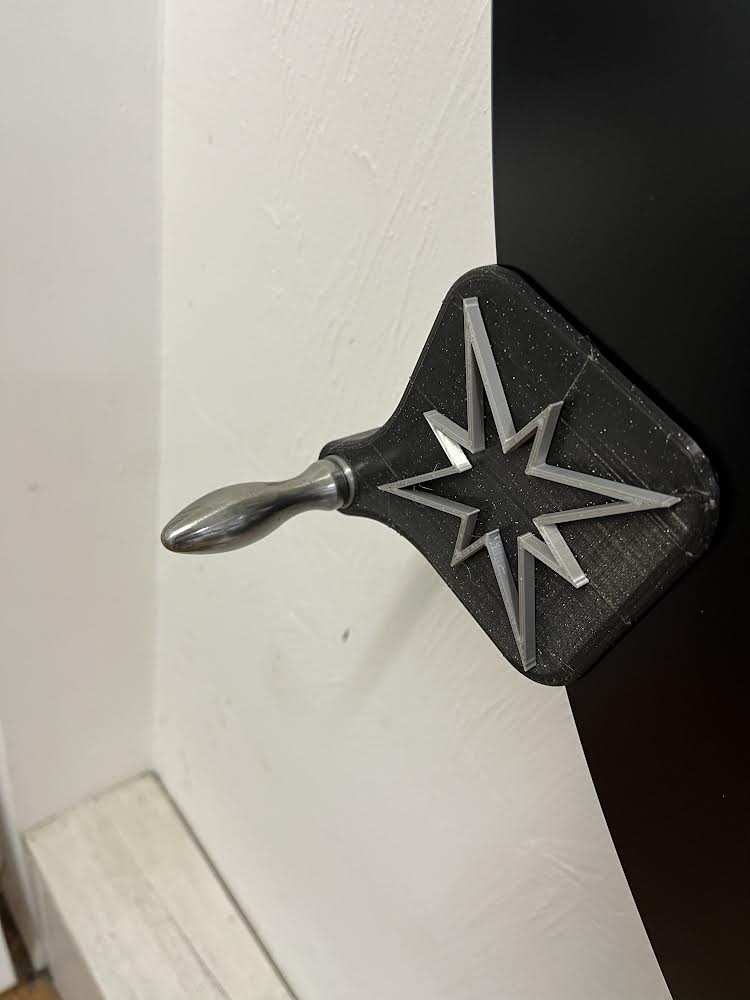
5. What emotions or atmospheres were you aiming to evoke in viewers with this piece?
The title of the piece is “The Magic of Dark Skies – Innocence and wonder” and I was particularly keen to try and capture that “oh wow!” moment when, as a child we see our first shooting star or if we are lucky enough, are shown Jupiter / Saturn / the moon / a galaxy through a telescope. We are all children in our heart, particularly when compared against the ageless wisdom of the universe and I wanted to allow a moment of escapism for children and adults alike.
I suppose, I also wanted to pay a small homage to the beautiful novella “The Little Prince” by Antoine de Saint Exupery – a book that had a profound effect on me. One of the central tenets of the book is that you have to view existence with a child’s eyes to really understand the magic. In the book a fox tells the Little Prince a secret – “Only the heart can see clearly because the eyes miss what is important” and at another point the Little Prince also says “Only the children know what they are looking for”. In the book the Little Prince also visits a number of small asteroids where he learns various lessons, mostly at the expense of adults. Hence my piece combines a magical universe, small planetoids and children presumably knowing what they are looking for.
Additionally, a number of the foundations underpinning our existence here on Earth don’t really have that much relevance on a universal scale – time would be one and direction another. There is no direction in space, it is a human construct to make sense of the (incomplete) 3D reality our brains function within and I was keen to represent a lack of importance of direction in my piece. Hence one figure on the central planet is always rising when one is setting and you can hopefully view the piece from any angle of rotation with just as much enjoyment.
The observant will notice that there is both a little girl and a little boy looking through telescopes. It was also important for me to capture a subtle nod to the fact that astronomy and indeed science more broadly is something for all regardless of gender or indeed any other sub grouping.
6. Did you draw from personal experiences or specific locations when creating this representation of Dark Skies?
During my Physics studies I did some work on Astrophysical jets from Young Stellar Objects and these are jets of materials produced from baby stars. These baby stars form inside clouds of collapsing dust and are often locations where the 3 types of nebulae can be seen (reflection, emission and absorption (dark)). I tried very hard to include all 3 types of nebulae in the piece and the Unison Colour darks were great for producing the inky darkness of absorption nebulae. Below are two more artworks using the Dark Skies palette showing these.
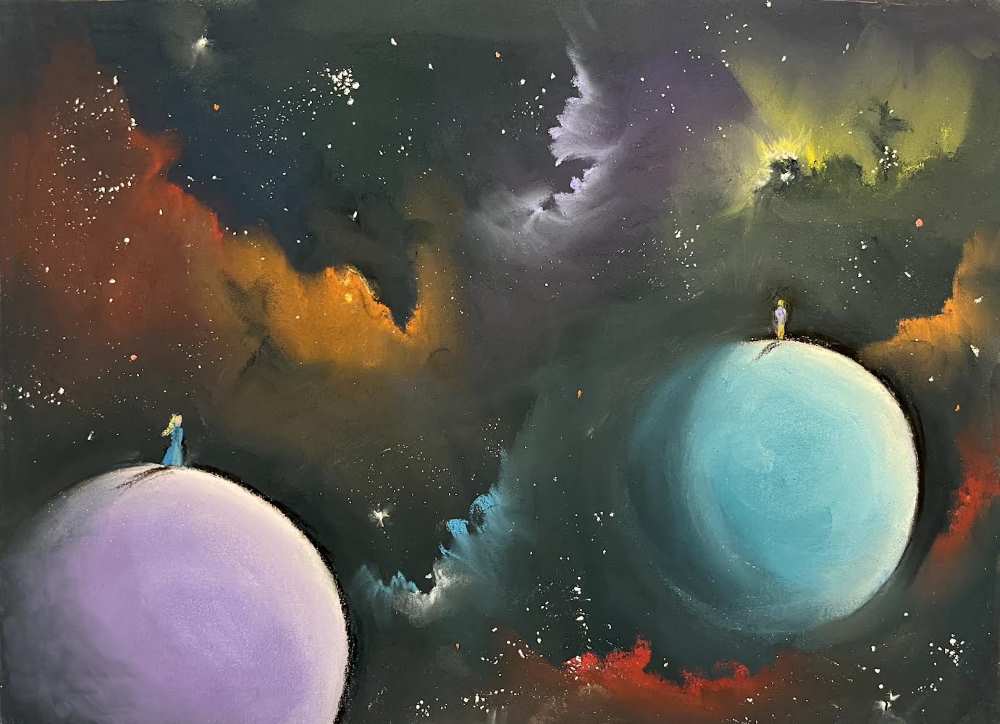
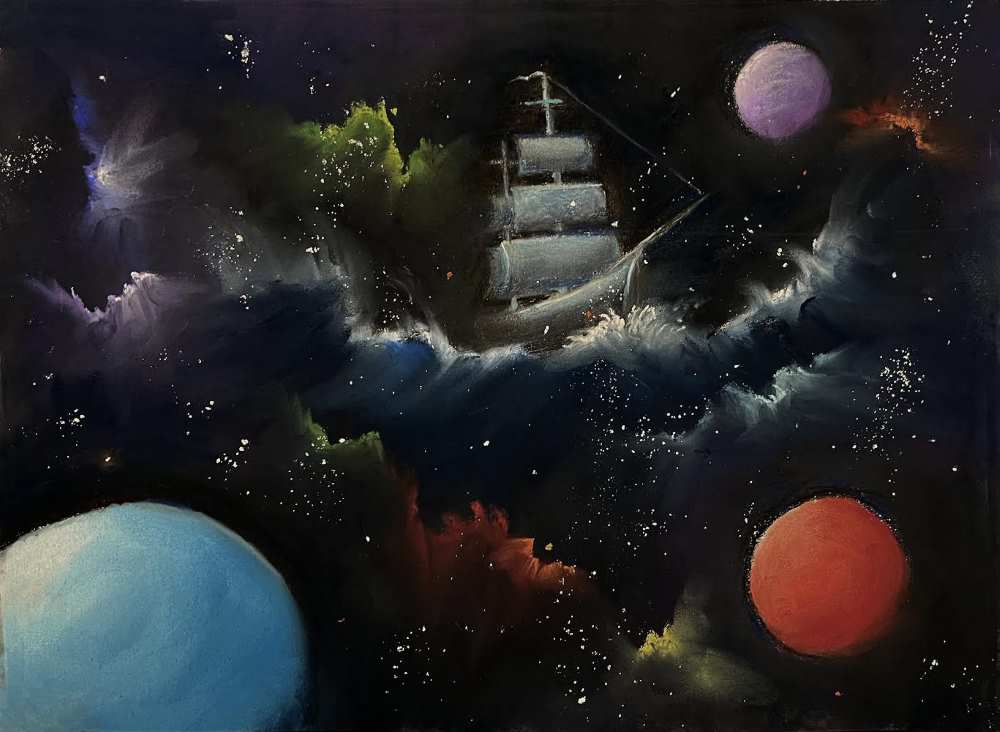
Additionally, during my time in the Royal Navy I was able to view the stars from far out on the ocean where there really is no light pollution – I challenge anyone seeing the skies from a pristine location not to be deeply moved by the experience. I’m also a keen amateur astronomer and the really funny thing is that despite celestial objects having the most fantastic evocative names nearly everything appears as a little fuzzy grey blob when viewed through a terrestrial telescope – particularly where there is light pollution. I wanted this piece to be the opposite of this and for everything to look like those amazing false colour images from the space telescopes.
7. How do you think your artwork contributes to the broader conversation about preserving and appreciating natural darkness?
I hope that my piece takes people back to a time when skies were darker and the associated thrill achieved by looking at the night sky. I hope it touches on the magic in every child’s heart and I hope that the interactive rotating element generates an “oh wow” smile for anyone who tries it. I hope that people notice there’s both a little boy and girl on the central planet and this reinforces the message that dark skies are a gift for all to enjoy.
8. Where can we see more of your art?
My website is www.stephenfullerartist.com
Facebook: Stephen Fuller Pastel Artist
Instagram: @stephenfullerpastel
In Part Two we will be learning more about the work of Kristin Holm Dybvig and Amy Shuckburgh, with Part Three featuring William Morrison-Bell and Matilda Bevan.
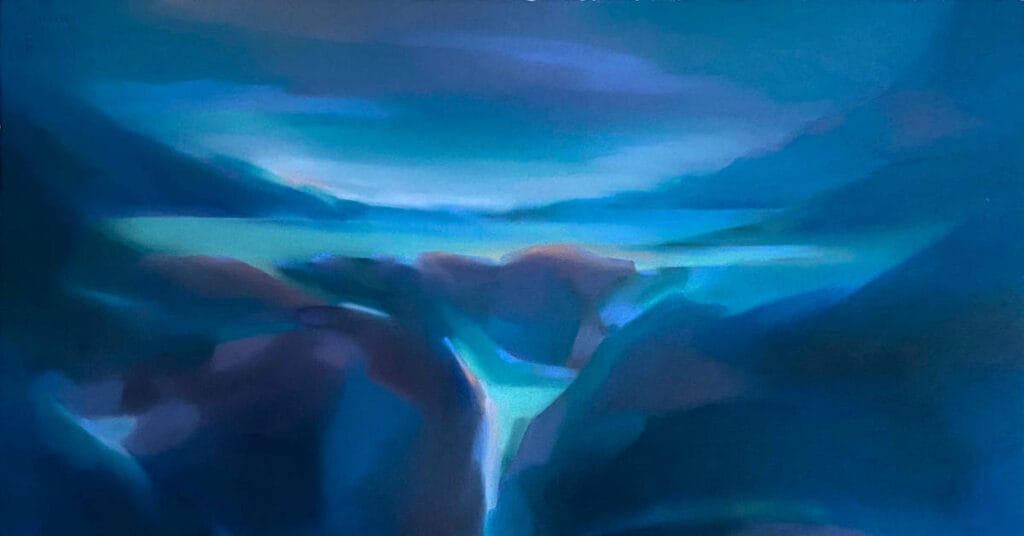
The Magic of Dark Skies: An exhibition in collaboration with Unison Colour and the Northumberland Dark Skies Park – Part II
